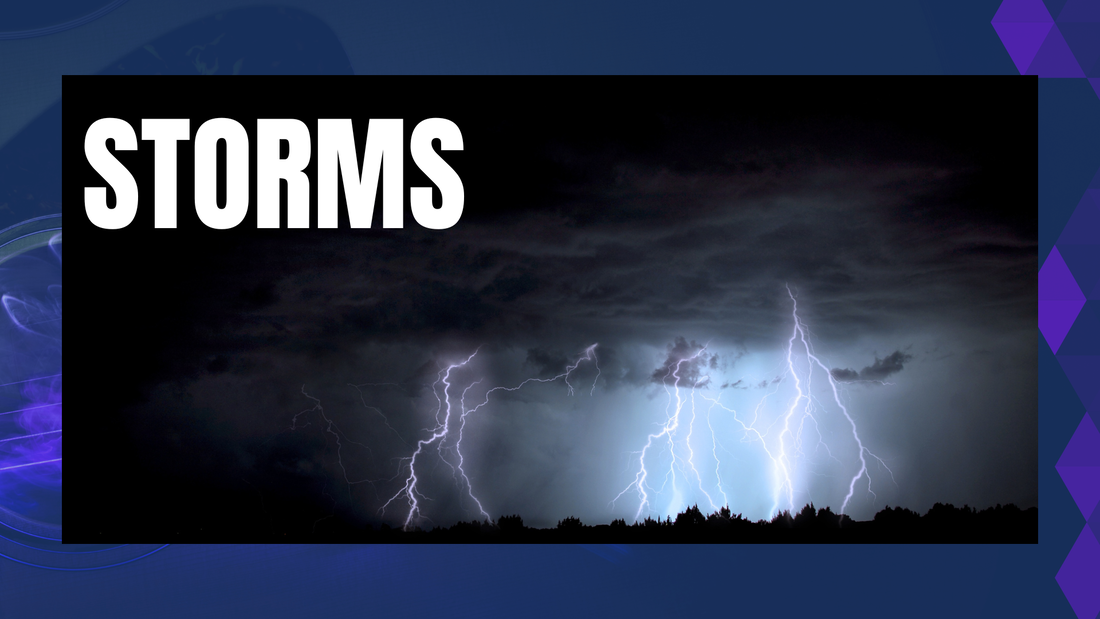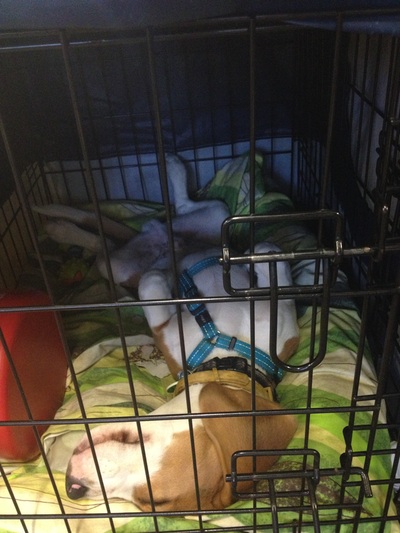Thunderstorms
Has your dog shown fear during thunderstorms or loud noises?
Has he/she shown any of the following signs before or during a storm?
If so, it is likely that your dog has astraphobia a fear or phobia of Thunderstorms.
Storm and noise phobia is unfortunately not uncommon.
Storms often are associated with loud noises (doors slamming), uncomfortable conditions, wind, rain, hail, atmospheric changes, different smells and the obvious thunder and lightning.
Any one of these changes (or more than one) can be the trigger for fear in your pet.
Your dog’s fear may initially appear mild, however left untreated; this can quickly escalate and get worse. Unfortunately, your dog may escape your house/yard and is at danger of becoming lost, injured or even killed.
But all hope is not lost. You can put things in place to help you and your pooch.
Here are some things that may help:
Look ahead for predictions of thunderstorms.
The following websites are useful:
You can also download apps for your smartphones or tablets. The apps I have are:
In Brisbane, you can sign up for the Brisbane City Council Early Warning Alert System. Alerts can be sent as email, text or a voice message to your landline phone.
You can find information regarding this service at http://www.brisbane.qld.gov.au/community/community-safety/disasters-emergencies/severe-weather-alerts/brisbane-early-warning-alert-service
Obviously once storm season is upon us, this can become an unpredictable time of year with little chance of setting up a training program prior to the storms. During Winter – try and desensitize your dog to storms, noises etc.
Has he/she shown any of the following signs before or during a storm?
- Shaking/trembling
- Pacing
- Panting
- Drooling
- Dilated pupils
- Whining
- Escaping
- Cowering/hiding
- Unable/Unwilling to eat
If so, it is likely that your dog has astraphobia a fear or phobia of Thunderstorms.
Storm and noise phobia is unfortunately not uncommon.
Storms often are associated with loud noises (doors slamming), uncomfortable conditions, wind, rain, hail, atmospheric changes, different smells and the obvious thunder and lightning.
Any one of these changes (or more than one) can be the trigger for fear in your pet.
Your dog’s fear may initially appear mild, however left untreated; this can quickly escalate and get worse. Unfortunately, your dog may escape your house/yard and is at danger of becoming lost, injured or even killed.
But all hope is not lost. You can put things in place to help you and your pooch.
Here are some things that may help:
Look ahead for predictions of thunderstorms.
The following websites are useful:
- Bureau of Meteorology http://www.bom.gov.au/
- Willy Weather http://www.willyweather.com.au/
- Weatherzone http://www.weatherzone.com.au/
You can also download apps for your smartphones or tablets. The apps I have are:
- Willy Weather
- Weatherzone
- Emergency Aus – you can set up a watchzone for a radius around your home.
In Brisbane, you can sign up for the Brisbane City Council Early Warning Alert System. Alerts can be sent as email, text or a voice message to your landline phone.
You can find information regarding this service at http://www.brisbane.qld.gov.au/community/community-safety/disasters-emergencies/severe-weather-alerts/brisbane-early-warning-alert-service
Obviously once storm season is upon us, this can become an unpredictable time of year with little chance of setting up a training program prior to the storms. During Winter – try and desensitize your dog to storms, noises etc.
If you have time:
- Build a safe space for your dog. Use a decibel metre to ensure it is as quiet and protected as possible - this could be a crate covered in foam soundproofing and heavy blankets, a wardrobe or internal bathroom. Teach your dog to use these area by pairing with long lasting chews, lick mats and snuffle mats.
- Begin getting your dog used to the sounds (if you have time) using a recording and playing it at a low level that does not cause your dog to react.
- There are several commercial storm CD’s available, and also a good app available for iPhone & android called Sound Proof Puppy Training. You can also find several on YouTube. Mix it up and use a couple of different ones.
- Start pairing the sound of the storms (wind, rain, thunder), with something your dog finds valuable (BBQ chicken usually works well), or play games and have pleasant interactions.
- If your dog is comfortable, slowly increase the level of the sound. Do not rush this, do this over a period of days to weeks and sometimes even months.
- Always pair the sound with something the dog values.
- If your dog starts to show signs indicating he/she is uncomfortable, immediately reduce the volume and take your training back a few steps.
But what can I do now? There is a storm predicted tonight!
- Bring your dog inside.
- Do your best not to react to the storm yourself. If your dog sees you showing signs that you are concerned (remember dogs are great at reading body language), you may just make their fear worse.
- If your dog can be distracted with food or chews – give him/her a long lasting chew or food dispensing toy. Chewing & licking releases endorphins and may help your dog settle.
- Play loud music or have the volume on the TV up high.
- Close your blinds and curtains (be careful that any loose cords are removed or elevated so as not to be a strangulation risk for a panicked pooch).
- Keep the doors and windows closed.
- If need be use fans, air conditioning, or cool coats to keep your dog cool.
- If your dog wants to hide, let him/her.
- A crate trained dog may prefer to bunker down in a blanket covered crate. Crates really are a wonderful invention. However never place a frightened dog in a crate and lock them in. This can result in panic and further their risk of injury. For more information on crate training, please ask for the handout #11 Crate Training.
- Play calming music – classical music has been scientifically proven to reduce stress in dogs. Through a Dogs ear are commercially available CD’s designed to relax your pooch.
- Make sure your dog is wearing current identification and has a microchip with your current contact details.
- Never leave a choke collar on your dog, or tether your dog. If your dog panics he/she may strangle themselves resulting in injury or death.
- Try ADAPTIL – Dog Appeasing Pheromone – you can buy a spray and use this on a jacket/blanket/bandana – each application will last a few hours.
- Consider using a ThunderShirt (in hot weather wet the thundershirt first or have your dog in airconditioning). Thundershirts work by applying a gentle pressure over your dog’s torso. This pressure can feel like a hug, and has a calming effect on many dogs. http://www.thundershirt.com/MLB.aspx
- You could also apply a T-Touch Wrap – this can work in a similar way to the ThunderShirt. However never leave this wrap on an unsupervised dog. I always worry that the dog in its panic could cause the wrap to move and act like a noose. Learn more about TTouch at http://www.ttouchaustralia.com.au/
- Talk to your Veterinarian about available treatment options. Medications are available that can be used both long term (usually take a minimum of 3 to 6 weeks to reach a stable state) and short term (use a few hours prior to the storm).
“A 2003 study by veterinarians at the University of Georgia found that 30 out of 32 dogs with storm phobia showed significant improvement when given medication combined with behavior modification and desensitization”.
(Crowell-Davis et al., 2014)
- Avoid going out and leaving your dog unsupervised.
- If you must leave, have someone stay with your dog – direct supervision is important to prevent injury, heat stress from panic or escape.
In the event that your dog does go missing, contact your local council, RSPCA, animal rescues, 24 hour vets, local veterinarians and local newspapers as soon as possible.
Some useful numbers:
RSPCA Lost and Found...........................................................................07 3426 9999
RSPCA Animal Ambulance......................................................................1300 852 188
Brisbane City Council..............................................................................07 3403 8888
Logan City Council...................................................................................1300 156 426
Moreton Bay Regional Council...............................................................07 3205 0555
Animal Emergency Service (Springwood)..............................................07 3423 1888
Animal Emergency Service (Carrara)......................................................07 5559 1599
Animal Emergency Centre (Woolloongabba).........................................07 3456 0500
Manly Road Veterinary Hospital..............................................................07 3396 9733
BVSC Emergency (Albany Creek)..............................................................07 3264 9400
Pet Emergency (Stafford)...........................................................................07 3359 5333
RSPCA Lost and Found...........................................................................07 3426 9999
RSPCA Animal Ambulance......................................................................1300 852 188
Brisbane City Council..............................................................................07 3403 8888
Logan City Council...................................................................................1300 156 426
Moreton Bay Regional Council...............................................................07 3205 0555
Animal Emergency Service (Springwood)..............................................07 3423 1888
Animal Emergency Service (Carrara)......................................................07 5559 1599
Animal Emergency Centre (Woolloongabba).........................................07 3456 0500
Manly Road Veterinary Hospital..............................................................07 3396 9733
BVSC Emergency (Albany Creek)..............................................................07 3264 9400
Pet Emergency (Stafford)...........................................................................07 3359 5333
References:
Crowell-Davis, S., Seibert, L., Sung, W., Parthasarathy, V. and Curtis, T. (2014). AVMA - Journal of the American Veterinary Medical Association - 222(6):744 - Abstract. [online]
Avmajournals.avma.org. Available at: http://avmajournals.avma.org/doi/abs/10.2460/javma.2003.222.744 [Accessed 6 Nov. 2014].
Overall, K. (2014). Storm Phobias. [online] dvm360.com. Available at: http://veterinarynews.dvm360.com/storm-phobias?id=&pageID=1&sk=&date= [Accessed 6 Nov. 2014].
Storm phobia treatment in dogs. (2004). Advances in Small Animal Medicine and Surgery, 17(2), pp.3-4.
Throughadogsear.com, (2014). Through a Dog's Ear - Music Therapy for the Prevention and Treatment of Canine Anxiety!. [online] Available at: http://throughadogsear.com/ [Accessed 6 Nov. 2014].
Crowell-Davis, S., Seibert, L., Sung, W., Parthasarathy, V. and Curtis, T. (2014). AVMA - Journal of the American Veterinary Medical Association - 222(6):744 - Abstract. [online]
Avmajournals.avma.org. Available at: http://avmajournals.avma.org/doi/abs/10.2460/javma.2003.222.744 [Accessed 6 Nov. 2014].
Overall, K. (2014). Storm Phobias. [online] dvm360.com. Available at: http://veterinarynews.dvm360.com/storm-phobias?id=&pageID=1&sk=&date= [Accessed 6 Nov. 2014].
Storm phobia treatment in dogs. (2004). Advances in Small Animal Medicine and Surgery, 17(2), pp.3-4.
Throughadogsear.com, (2014). Through a Dog's Ear - Music Therapy for the Prevention and Treatment of Canine Anxiety!. [online] Available at: http://throughadogsear.com/ [Accessed 6 Nov. 2014].



